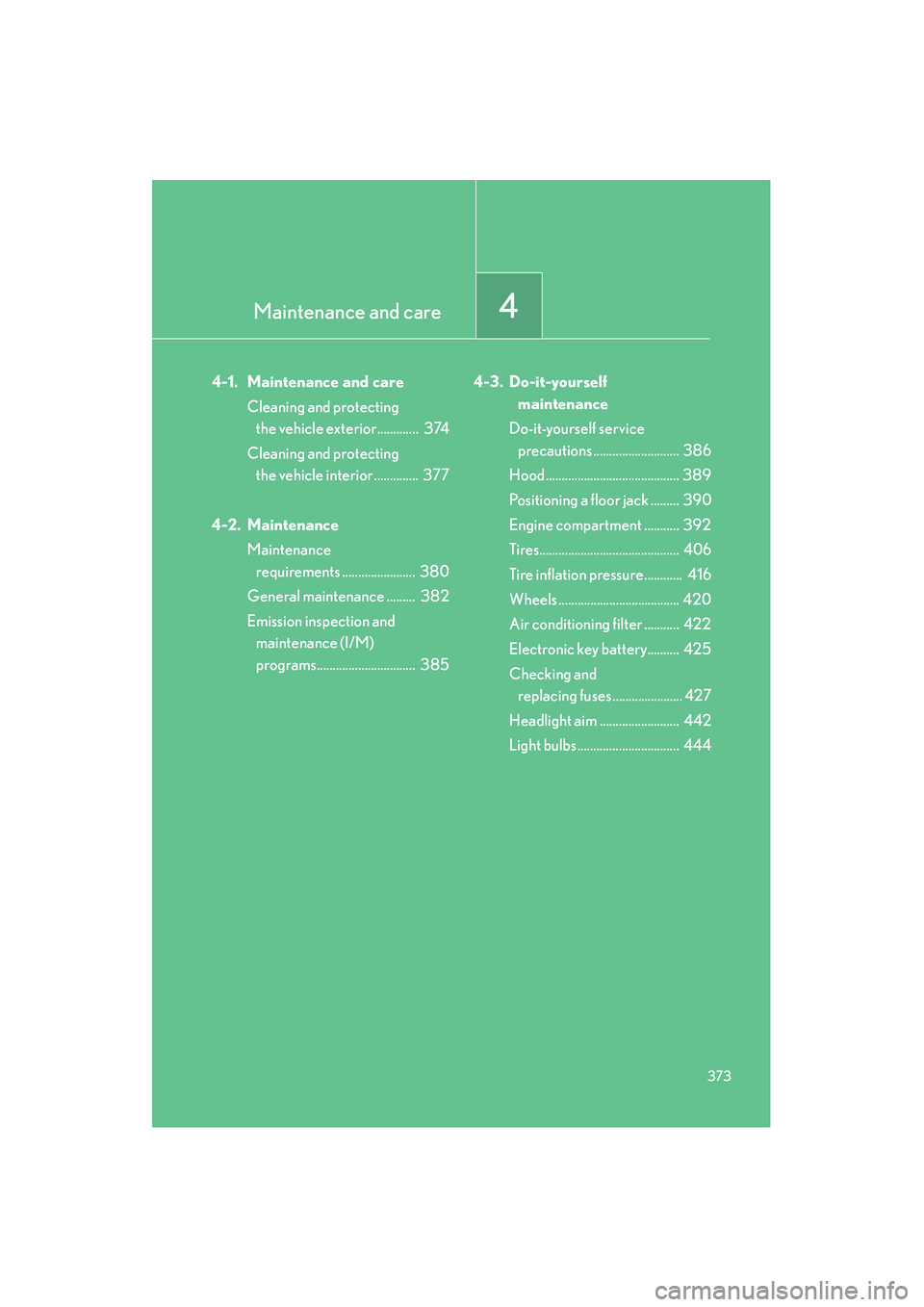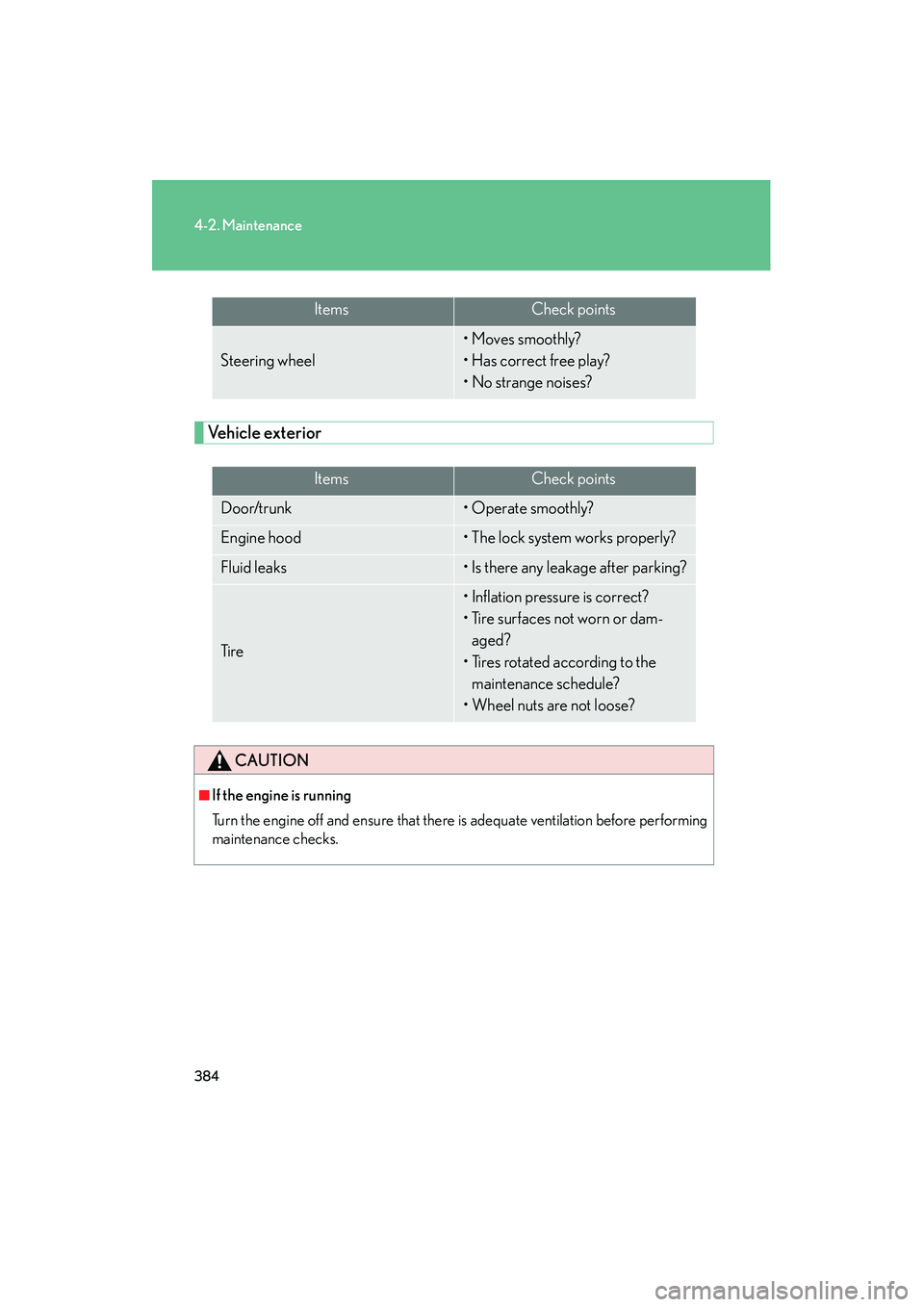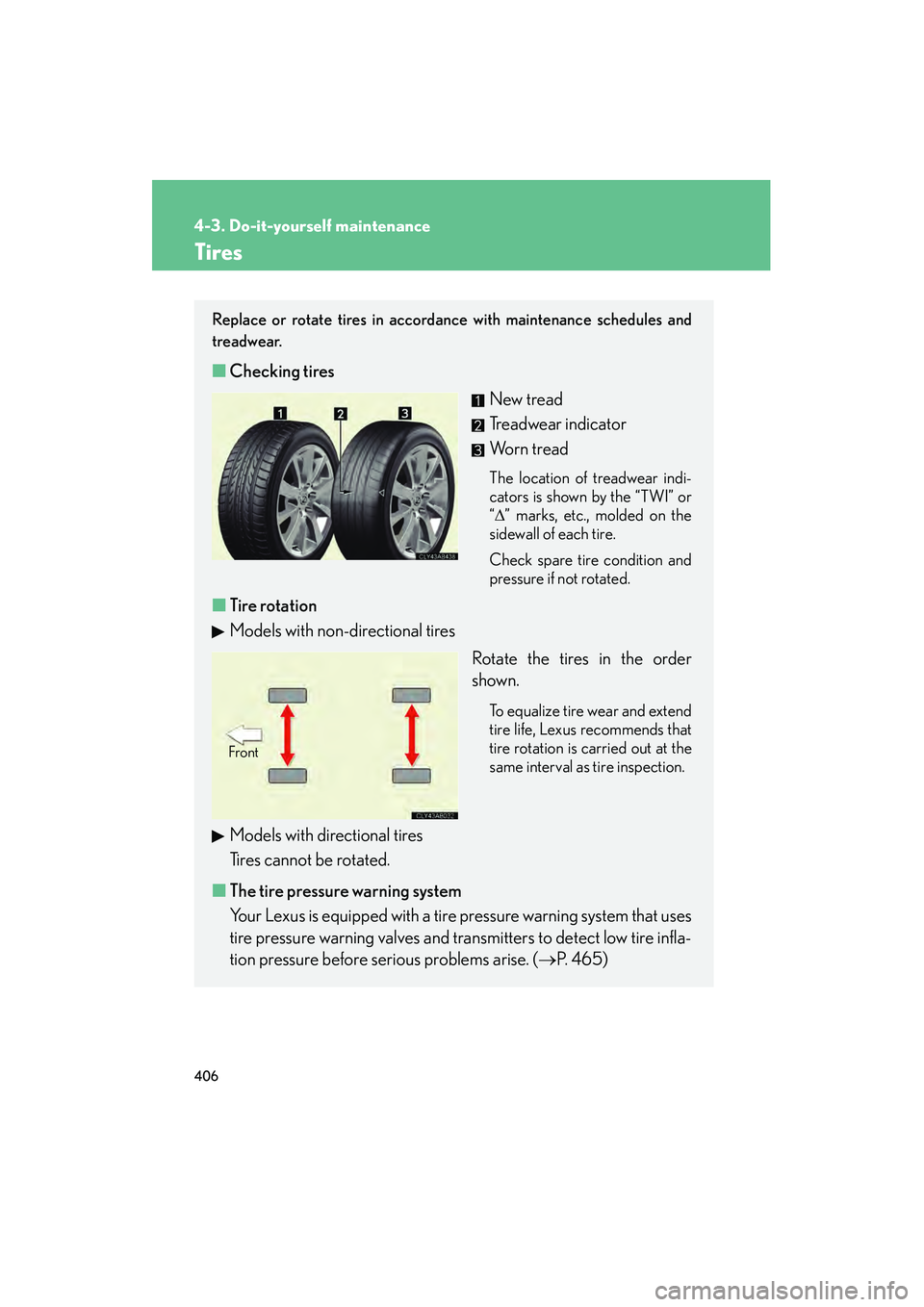tires Lexus IS250C 2010 User Guide
[x] Cancel search | Manufacturer: LEXUS, Model Year: 2010, Model line: IS250C, Model: Lexus IS250C 2010Pages: 586, PDF Size: 31.62 MB
Page 224 of 586

223
2-5. Driving information
2
When driving
10_IS250C/350C_U
NOTICE
■Repairing or replacing snow tires
Request repairs of and obtain replacement snow tires from Lexus dealers or legiti-
mate tire retailers.
This is because the removal and attachment of snow tires affects the operation of
the tire air pressure sensor.
■Fitting tire chains
The tire air pressure sensor may not function correctly when tire chains are fitted.
Page 361 of 586

360
3-7. Other interior features
10_IS250C/350C_U
■Auxiliary box (vehicles with run-flat tires)
Pull the lever upward to lift up
the luggage mat.
The lever can be hooked on the
edge of the trunk.
STEP1
STEP2
Page 374 of 586

Maintenance and care4
373
10_IS250C/350C_U
4-1. Maintenance and careCleaning and protecting the vehicle exterior............. 374
Cleaning and protecting the vehicle interior .............. 377
4-2. Maintenance Maintenance requirements ....................... 380
General maintenance ......... 382
Emission inspection and maintenance (I/M)
programs............................... 385 4-3. Do-it-yourself
maintenance
Do-it-yourself service precautions ........................... 386
Hood .......................................... 389
Positioning a floor jack ......... 390
Engine compartment ........... 392
Tires............................................ 406
Tire inflation pressure............ 416
Wheels ...................................... 420
Air conditioning filter ........... 422
Electronic key battery.......... 425
Checking and replacing fuses ...................... 427
Headlight aim ......................... 442
Light bulbs................................ 444
Page 385 of 586

384
4-2. Maintenance
10_IS250C/350C_U
Vehicle exterior
ItemsCheck points
Steering wheel
• Moves smoothly?
• Has correct free play?
• No strange noises?
ItemsCheck points
Door/trunk• Operate smoothly?
Engine hood• The lock system works properly?
Fluid leaks• Is there any leakage after parking?
Ti r e
• Inflation pressure is correct?
• Tire surfaces not worn or dam-aged?
• Tires rotated according to the maintenance schedule?
• Wheel nuts are not loose?
CAUTION
■If the engine is running
Turn the engine off and ensure that there is adequate ventilation before performing
maintenance checks.
Page 407 of 586

406
4-3. Do-it-yourself maintenance
10_IS250C/350C_U
Tires
Replace or rotate tires in accordance with maintenance schedules and
treadwear.
■Checking tires
New tread
Treadwear indicator
Worn tread
The location of treadwear indi-
cators is shown by the “TWI” or
“∆ ” marks, etc., molded on the
sidewall of each tire.
Check spare tire condition and
pressure if not rotated.
■ Tire rotation
Models with non-directional tires
Rotate the tires in the order
shown.
To equalize tire wear and extend
tire life, Lexus recommends that
tire rotation is carried out at the
same interval as tire inspection.
Models with directional tires
Tires cannot be rotated.
■ The tire pressure warning system
Your Lexus is equipped with a tire pressure warning system that uses
tire pressure warning valves and transmitters to detect low tire infla-
tion pressure before serious problems arise. ( →P. 465)
Front
Page 408 of 586

407
4-3. Do-it-yourself maintenance
4
Maintenance and care
10_IS250C/350C_U
Directional tiresTire direction marks
The tire sidewalls are marked with
arrows indicating the rolling direc-
tion of the tire. If mounted on the
wrong side of the vehicle, direc-
tional tires will not perform prop-
erly.
Installing tire pressure warning valves and transmitters
When replacing tires or wheels, tire pressure warning valves and trans-
mitters must also be installed.
When new tire pressure warning valves and transmitters are installed,
new tire pressure warning valve and transmitter ID codes must be regis-
tered in the tire pressure warning computer and tire pressure warning
system must be initialized. Have tire pressure warning valve and transmit-
ter ID codes registered by your Lexus dealer. ( →P. 4 0 9 )
Initializing the tire pressure warning system
■ The tire pressure warning system mu st be initialized in the following
circumstances:
● When changing the tire inflation pressure by changing traveling
speed or load weight, etc.
● When changing the tire size.
When the tire pressure warning system is initialized, the current tire
inflation pressure is set as the pressure benchmark.
Page 410 of 586

409
4-3. Do-it-yourself maintenance
4
Maintenance and care
10_IS250C/350C_U
Registering and selecting ID codes
To select tire pressure warning valve and transmitter ID codes, use the
satellite switch. ( →P. 3 4 9 )
■ Registering ID codes
2 sets of tire pressure warning valve and transmitter ID codes can be
registered. Once a second set of tires is registered at “2ND”, you can
switch between tire set settings simply by pressing the tire pressure
warning select switch.
There are 2 settings:
“MAIN” position: The ID code of the tire pressure warning valve and
transmitter on the tires originally installed on the vehicle is registered.
“2ND” position: The ID code is not registered. When you replace a
new set of tires, purchase tire pressure warning valves and transmitters
from your Lexus dealer and have the new ID code registered by your
Lexus dealer.
Page 411 of 586

410
4-3. Do-it-yourself maintenance
10_IS250C/350C_U■
Selecting ID codes
When replacing tires, make sure to select the ID code set that matches
the new tire set. If the tire pressure select switch is set to the wrong tire
setting, the tire pressure warning system will not operate properly.
After driving for about 20 minutes, the tire pressure warning light
comes on after blinking for 1 minute to indicate a system malfunction.
Tire pressure warning valve and
transmitter ID code settings dis-
play
Press “<” or “>” repeatedly until
the setting display appears.
Switching ID codes
Press the “ON/OFF” button to
switch between “MAIN” and
“2ND” ID codes.
Page 412 of 586

411
4-3. Do-it-yourself maintenance
4
Maintenance and care
10_IS250C/350C_U
■When to replace your vehicle’s tires
Tires should be replaced if:
●You have tire damage such as cuts, splits, cracks deep enough to expose the
fabric or bulges indicating internal damage
●A tire goes flat repeatedly or cannot be properly repaired due to the size or
location of a cut or other damage
If you are not sure, consult with your Lexus dealer.
■Replacing tires and wheels
If the ID code of the tire pressure warning valve and transmitter is not registered,
the tire pressure warning system will not work properly. After driving for about 20
minutes, the tire pressure warning light comes on after blinking for 1 minute to indi-
cate a system malfunction.
■Tire life
Any tire over 6 years old must be checked by a qualified technician even if they
have seldom or never been us ed or damage is not obvious.
■If the tread wears down below 0. 16 in. (4 mm) on snow tires
The effectiveness of snow tires is lost.
■Low profile tires
Generally, low profile tires will wear more rapidly and tire grip performance will be
reduced on snowy and/or icy roads when compared to standard tires. Be sure to
use snow tires or tire chains
* on snowy and/or icy roads and drive carefully at a
speed appropriate for road and weather conditions.
*: Tire chains cannot be mounted on 18-inch tires.
Page 413 of 586

412
4-3. Do-it-yourself maintenance
10_IS250C/350C_U
■Maximum load of tire
Check that the maximum load of the replacement tire is greater than 1 /2 of the
Gross Axle Weight Ratings (GAWR) of either the front axle or the rear axle, which-
ever is greater.
■Tire types
1 Summer tiresSummer tires are high-speed performance tires best suited to highway driving
under dry conditions. Since summer tires do not have the same traction perfor-
mance as snow tires, summer tires are inadequate for driving on snow-covered
or icy roads. For driving on snow-covered roads or icy roads, the use of snow tires
is recommended. When installing snow tires, be sure to replace all four tires.
2 All season tires All season tires are designed to provide better traction in snow and to be ade-
quate for driving in most winter conditions, as well as for use year round. All sea-
son tires, however, do not have adequate traction performance compared with
snow tires in heavy or loose snow. Also, al l season tires fall short in acceleration
and handling performance compared with summer tires in highway driving.
3Snow tires
For driving on snow-covered roads or icy roads, we recommend using snow tires.
If you need snow tires, select tires of the same size, construction and load capac-
ity as the originally installed tires. Since your vehicle has radial tires as original
equipment, make sure your snow tires also have radial construction. Do not install
studded tires without first checking local regulations for possible restriction.
Snow tires should be installed on all wheels. ( →P. 220)
■Initializing the tire pressure warning system
Initialize the tire pressure warning system with the tire inflation pressure adjusted to
the specified level. For the GAWR, see the Certification Label.
For the maximum load of the tire, see the load
limit at maximum cold tire inflation pressure
mentioned on the sidewall of the tire.
(
→P. 545)